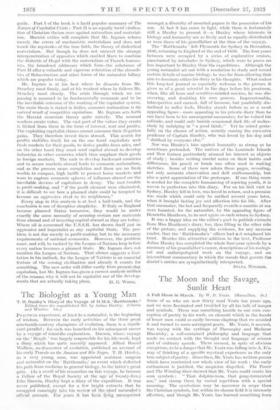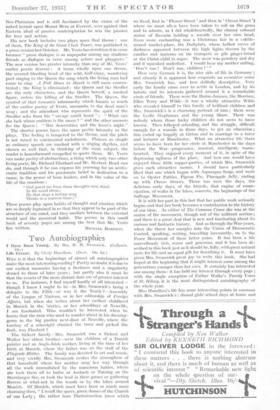The Moon and the Savage, Sunlit Heart
A Full Moon in March. By W. B. Yeats. (Macmillan. 5s.) SOME of us who are now thirty read Yeats ten years ago, and we were fascinated and troubled by all his talk of images and symbols. There was something hostile to our own con4 ception of poetry in his work, an element which in the hand of lesser men could so easily become claptrap that we avoided it and turned to more astringent poets. Mr. Yeats, it seemed, was toying with the verbiage of Theosophy and Madame Blavatsky, a self-contained philosophy, and language that made no contact with the thought and language of science and of ordinary speech. There seemed, in spite 'of obvious exceptions, to be a danger that Mr. Yeats was falling into A. E'si way of thinking of a specific mystical experience as the only true subject of poetry. Since then, Mr. Yeats has written poems which have reoriented our whole view of his work : the early enthusiasm is justified, the suspicion dispelled. The Tower and The Winding, Stair showed that Mr. Yeats could create his own symbols : " That dolphin-torn, that gong-tormented sea," and stamp them by varied repetition with a special meaning. The symbolism may be narrower in scope than the Christian symbols, but within its chosen field it is intensely effective, and though Mr. Yeats has learned something from
Neo-Platonism and is still fascinated by the vision of the naked hermit upon Mount Meru or Everest, over ftgainst that Eastern ideal of passive contemplation he sets the passion fcir love and action.
. His new book includes two plays upon that theme : one
of them, The King of the Great Clock Tower, was published in a prose version last October. Mr. Yeats has rewritten it in verse
because "prose dialogue is as unpopular among my studious friends as dialogue in verse among actors and playgoers."
The new version has greater intensity than any of Mr. Yeats' earlier poetic dramas : it turns wholly upon one theme, the severed bleeding head of the wild, half-crazy, wandering poet singing to the Queen the song which the living man had
come to sing. .4 Full Moon in March is still more concen- trated: the King is eliminated ; the Queen and the Stroller are the only characters, and the Queen herself, a masked
figure, orders the killing of the Stroller. The Queen, the symbol of that romantic inhumanity which haunts so much of the earlier poetry of Yeats, succumbs to the dead man's song ; and the attendant who represents the spirit of the Stroller asks from his " savage sunlit heart " : " What can she lack whose emblem is the moon ? " and the other answers for the Queen : "But desecration and the lover's night."
The shorter poems have the same poetic intensity as the plays. The feeling is tempered to the theme, and the pitch is not raised to sentimental melodrama. Phrases as simple as ordinary speech are marked with a singing rhythm, and chosen so well that, in thinking of the same subject, the reader is henceforward compelled to quote them. Mr. Yeats can make poetry of abstractions, a thing which only two other living poets, Mr. Richard Eberhart and Mr. Herbert Read can do, and through it he can express his yearning for an aristo- cratic tradition and his passionate belief in dedication to a cause, in the power of born leaders, and in the value of the life of the emotions : " God guard me from those thoughts men think In the mind alone; He that sings a lasting song Thinks in a marrow-bono ; These poems play upon habits of thought and emotion which are so deeply ingrained in us that they appear to be part of the structure of our mind, and they mediate between the external world and the ancestral habit. The poems in this small book of seventy pages arc among the best that Mr. Yeats



































 Previous page
Previous page